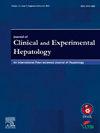局部治疗在肝细胞癌活体肝移植术后存活中的作用——来自一个大容量中心的经验。
IF 3.3
Q2 GASTROENTEROLOGY & HEPATOLOGY
Journal of Clinical and Experimental Hepatology
Pub Date : 2024-12-19
DOI:10.1016/j.jceh.2024.102490
引用次数: 0
摘要
背景:肝移植(LT)前肝细胞癌(HCC)患者的局部治疗(LRT)除了降低分期和桥接外,在改善肿瘤生物学和LT后生存结局方面具有重要作用。我们回顾性分析了肝癌成人活体供肝移植(LDLT)数据库,比较了第一组(前期肝移植,米兰/UCSF/AFP1000 ng/ml内的HCC)的生存结果。我们还探讨了随访中复发的危险因素。方法:对2006年7月至2022年12月期间行LDLT治疗的HCC患者(n = 506, 1-348, 2 = 158)进行研究,排除偶发性HCC (n = 42)、其他组织学患者(n = 13)和住院死亡率(n = 43)。研究队列(n = 341)在倾向评分匹配后,分析第一组(n = 156)和第二组(n = 158)之间的生存结局(总生存期、OS和无病生存期、DFS)和复发危险因素。结果:与1组相比,2组表现出更好的平均OS和DFS (OS-133 vs. 107个月,P = NS, DFS-118 vs. 102个月,P = NS)。在米兰和UCSF标准组,长期OS(10年)优于组2,P = NS。与部分缓解和病情稳定的患者相比,LRT后完全病理缓解(cPR) (46.8%), OS和DFS显著改善;152月vs. 94月vs. 49月,P = 0.001; 147月vs. 75月vs. 41月,P = 0.006。受体年龄、肿瘤大小和lt前血清甲胎蛋白(AFP)是心肺复苏术的独立预测因子。复发的独立危险因素包括lt前AFP、UCSF以外的肿瘤、神经周围浸润和高级别肿瘤。结论:HCC局部治疗在病理反应完全的患者中提供了明显更好的OS和DFS。肝移植后复发的危险因素是甲胎蛋白水平,超过UCSF肿瘤,组织学上有PNI的高级别HCC。本文章由计算机程序翻译,如有差异,请以英文原文为准。
Role of Locoregional Therapy on Survival After Living Donor Liver Transplantation for Hepatocellular Carcinoma--Experience from a High-volume Center
Background
Locoregional therapy (LRT) in patients with hepatocellular carcinoma (HCC) before liver transplantation (LT) has a role in improving the tumor biology and post-LT survival outcome apart from downstaging and bridging. We retrospectively analyzed our database of adult living donor liver transplants (LDLT) for HCC, to compare the survival outcomes in Group-1 (upfront-LT, HCC within Milan/UCSF/AFP<1000 ng/ml) and Group-2 (LT post-LRT, HCC beyond UCSF/irrespective of tumor burden with AFP>1000 ng/ml). We also explored the risk factors for recurrence on follow-up.
Methods
A study group (n = 506, Group-1-348, Group-2 = 158) of patients with HCC who underwent LDLT between July 2006 and December 2022, excluding incidental HCC (n = 42), patients with other histology (n = 13) and in-hospital mortality (n = 43), were analyzed. Study cohort (n = 341), after propensity score matching, was analyzed for survival outcomes (overall survival, OS and disease-free survival, DFS) and risk factors for recurrence between Group-1 (n = 156) and Group-2 (n = 158).
Results
Group-2 exhibited a trend towards better mean OS and DFS compared to Group-1 (OS-133 vs. 107-months, P = NS, DFS-118 vs. 102-months, P = NS). Long-term OS (10-year) for those within Milan and UCSF criteria was superior in Group-2, P = NS. Complete pathological response (cPR) after LRT (46.8%), significantly improved OS and DFS compared to those with partial response and stable disease; 152 vs. 94 vs. 49 months, P = 0.001, and 147 vs. 75 vs. 41 months, P = 0.006, respectively. Recipient age, size of tumor, and pre-LT serum alpha-fetoprotein (AFP) were independent predictors of cPR. Independent risk factors for recurrence included pre-LT AFP, tumors beyond UCSF, perineural invasion, and high-grade tumors.
Conclusion
Locoregional therapy in HCC offers significantly better OS and DFS in those who had a complete pathological response. Risk factors for recurrence post-LT were AFP level, beyond UCSF tumors, and high-grade HCC with PNI on histology.
求助全文
通过发布文献求助,成功后即可免费获取论文全文。
去求助
来源期刊

Journal of Clinical and Experimental Hepatology
GASTROENTEROLOGY & HEPATOLOGY-
CiteScore
4.90
自引率
16.70%
发文量
537
审稿时长
64 days
 求助内容:
求助内容: 应助结果提醒方式:
应助结果提醒方式:


